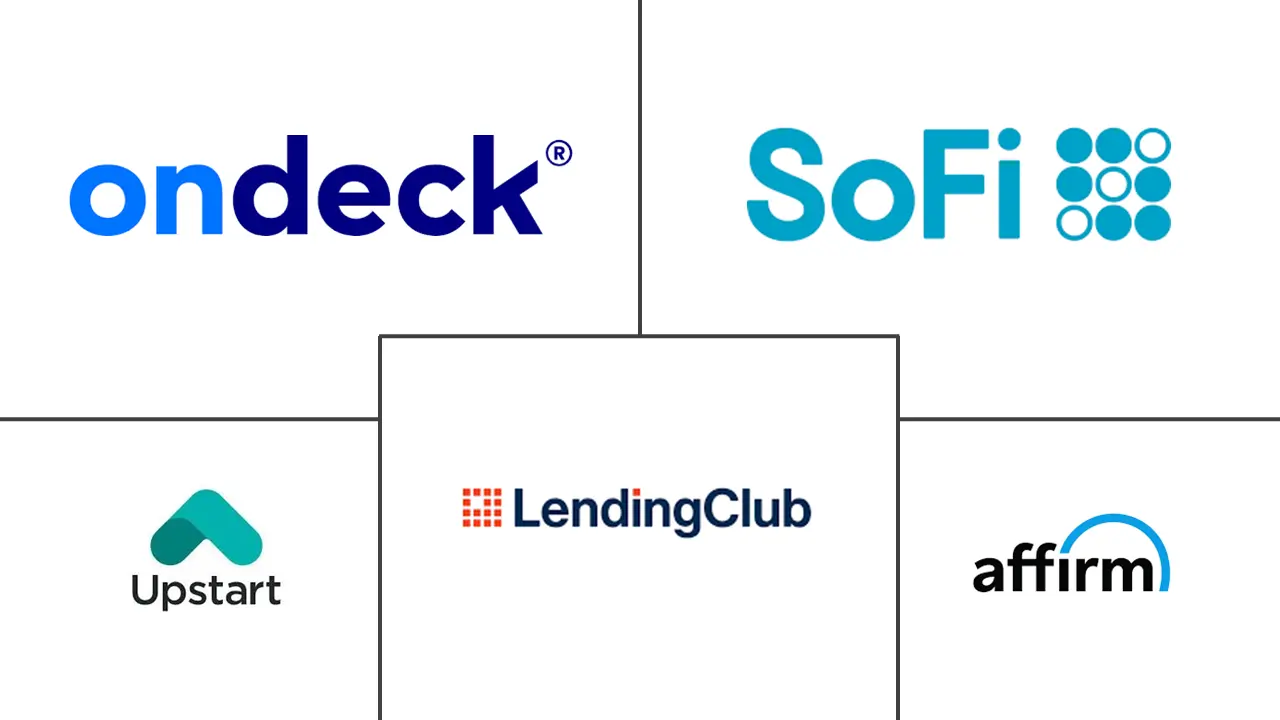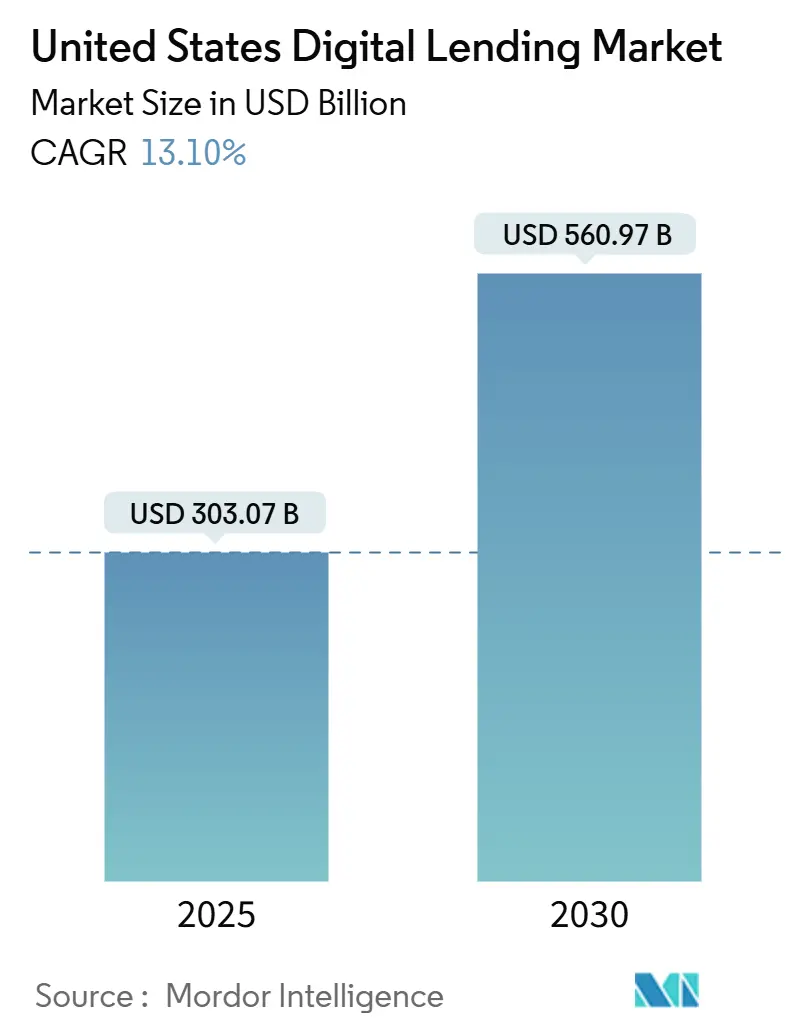
United States Digital Lending Market Analysis by Mordor Intelligence
The United States digital lending market reached USD 303.07 billion in 2025 and is forecast to reach USD 560.97 billion by 2030, advancing at a 13.10% CAGR. Momentum stems from AI-driven, mobile-first origination engines that cut credit-decision time to minutes, the rapid rollout of FedNow real-time payment rails, and the spread of embedded lending inside vertical SaaS platforms. Regulatory modernization is encouraging non-bank participation, while investor appetite for high-yield personal-loan collateral underpins securitization growth. Consumer borrowers dominate origination volume, and institutional investors are shifting toward whole-loan purchases to mitigate securitization volatility. Competitive intensity is heightening as traditional banks accelerate digital transformations to defend share, yet cybersecurity gaps and patchwork state “true-lender” rules temper near-term scalability.
Key Report Takeaways
- By borrower type, consumer lending held 62.87% of United States digital lending market share in 2024; the segment is advancing at a 14.20% CAGR to 2030.
- By provider type, whole-loan balance-sheet funding posted the fastest 14.90% CAGR through 2030, though traditional banks still retained 32.80% share in 2024.
- By funding source, P2P/fractional investors led with 52.50% of United States digital lending market size in 2024, while securitization is expanding at a 15.10% CAGR.
- By region, the Northeast captured 38.98% revenue share in 2024; the West Coast is projected to grow the fastest at 18.20% CAGR to 2030.
United States Digital Lending Market Trends and Insights
Drivers Impact Analysis
| Driver | (~) % Impact on CAGR Forecast | Geographic Relevance | Impact Timeline |
|---|---|---|---|
| Uptick of digitally-savvy borrowers | +2.1% | Global | Short term (≤ 2 years) |
| Growth in disposable income and credit demand | +1.8% | National (Northeast, West) | Medium term (2–4 years) |
| Near-instant, mobile-first origination times | +2.3% | Global | Short term (≤ 2 years) |
| AI-driven alternative-data credit scoring | +2.7% | Global | Medium term (2–4 years) |
| Embedded lending inside vertical SaaS platforms | +1.9% | National (West Coast hubs) | Medium term (2–4 years) |
| FedNow instant-payment rails enabling same-day funding | +1.4% | National | Long term (≥ 4 years) |
| Source: Mordor Intelligence | |||
AI-Driven Alternative-Data Credit Scoring
Machine-learning models now achieve 93% accuracy and 0.94 AUC-ROC, far outperforming traditional logistic regression. Lenders tap utility payments, real-time bank transactions, and even social signals to underwrite thin-file borrowers, expanding credit access and cutting default rates. Explainable-AI techniques such as Shapley values help satisfy regulators that remain vigilant on algorithmic fairness. Lendflow’s USD 15 million capital raise earmarked for embedded credit APIs underscores investor confidence in these methodologies.[1]Lendflow, “Series A Funding Announcement,” lendflow.com Momentum is likely to accelerate as underbanked groups seek mainstream credit and banks search for cost-efficient risk tools.
Embedded Lending Inside Vertical SaaS Platforms
Industry-specific software vendors integrate loan offers inside daily workflows, sidestepping conventional bank relationships. Lendica enables financing up to USD 2.5 million and shares revenue with partner platforms, lowering acquisition costs and boosting conversion. Healthcare, construction, and professional-services SaaS vendors supply granular cash-flow data that sharpens credit models, while Prime Financial Technologies delivers low-code APIs to deploy capital across multiple verticals. Early adopters report higher lifetime value as users tap lending, payments, and analytics from a single dashboard, knitting finance and operations together.
FedNow Instant-Payment Rails Catalysing Same-Day Funding
More than 600 institutions joined FedNow by mid-2024, doubling participation in six months.[2]Board of Governors, “FedNow Service Continues Rapid Adoption,” federalreserve.govInstant settlement lets lenders disburse funds minutes after approval, matching consumer expectations for immediacy. A Finastra survey shows 90% of businesses value real-time payments, with 42% willing to switch providers to access them.[3]Finastra, “Real-Time Payments Survey 2024,” finastra.com Community banks adopt FedNow to remain competitive, but must upgrade fraud-monitoring and 24/7 operations.
Near-Instant, Mobile-First Origination Times
Sixty-five percent of 2024 loan applications came via mobile, up from 54% in 2021. LendAPI processed 10 million applications in its first year, proving the scalability of API-first underwriting engines. Pre-filled forms using open-banking data shorten onboarding, while real-time identity checks cut abandonment. As digital ad costs rise, lenders view speed as a decisive conversion lever and invest accordingly.
Restraints Impact Analysis
| Restraint | (~) % Impact on CAGR Forecast | Geographic Relevance | Impact Timeline |
|---|---|---|---|
| Cyber-security and data-privacy breaches | -1.7% | Global | Short term (≤ 2 years) |
| Uncertain federal / state “true-lender” rules and rate caps | -2.1% | National (state level) | Medium term (2–4 years) |
| Rising customer-acquisition cost for fintech lenders | -1.4% | National (metro areas) | Short term (≤ 2 years) |
| Shrinking pool of prime borrowers → adverse-selection risk | -1.8% | National | Medium term (2–4 years) |
| Source: Mordor Intelligence | |||
Uncertain Federal / State “True-Lender” Rules and Rate Caps
Washington State’s 2024 statute and similar laws elsewhere muddy responsibility when banks and fintechs partner, raising compliance spend and slowing market entry. The CFPB’s USD 785.4 million budget emphasizes non-bank oversight, while New York’s USD 1 billion judgment against mis-stated merchant-cash-advance loans signals stricter enforcement.[4]Federal Deposit Insurance Corporation, “Banking and Fintech Competition Report 2024,” fdic.gov Many platforms divert capital from product roadmaps to legal teams, which could curb innovation until a federal framework arrives.
Shrinking Pool of Prime Borrowers → Adverse-Selection Risk
Pandemic-era savings lifted many subprime consumers into higher score bands, leaving riskier profiles concentrated among the remainder. Subprime auto delinquencies now exceed 2000 levels, yet migration skews data by removing rehabilitated borrowers from the denominator. Digital lenders battle for scarce prime applicants who leverage comparison sites to command lower rates, compressing margins. Near-prime cohorts sometimes outperform primes in downturns, highlighting the need for nuanced segmentation. Lenders refine AI models to avoid adverse selection while still hitting growth targets.
Segment Analysis
By Borrower Type: Consumer Dominance Drives Platform Innovation
Consumer loans accounted for 62.87% of United States digital lending market size in 2024 and are forecast to expand at a 14.20% CAGR. SoFi originated USD 7.2 billion in Q1 2025 and reported an average borrower FICO of 747, underscoring affluent demand. Platforms focus on frictionless onboarding, in-app account servicing, and cross-selling to maximize lifetime value. Business lending remains smaller but benefits from embedded finance within SaaS platforms that monitor cash flow in real time. As SMB borrowers desire revolving structures aligned with invoice cycles, lenders tailor underwriting to sector-specific KPIs. Consumer providers widen engagement by bundling banking, investing, and insurance, lifting per-customer revenue.
Competitive intensity in the consumer arena raises acquisition costs, so speed, transparency, and alternative-data credit models act as differentiators. Conversely, business-lending platforms cultivate vertical expertise and relationship depth. Borrower expectations influenced by e-commerce push all segments toward instant approval and funding. The blend of high data granularity and AI insights positions both segments for sustained growth, though regulatory oversight differs.
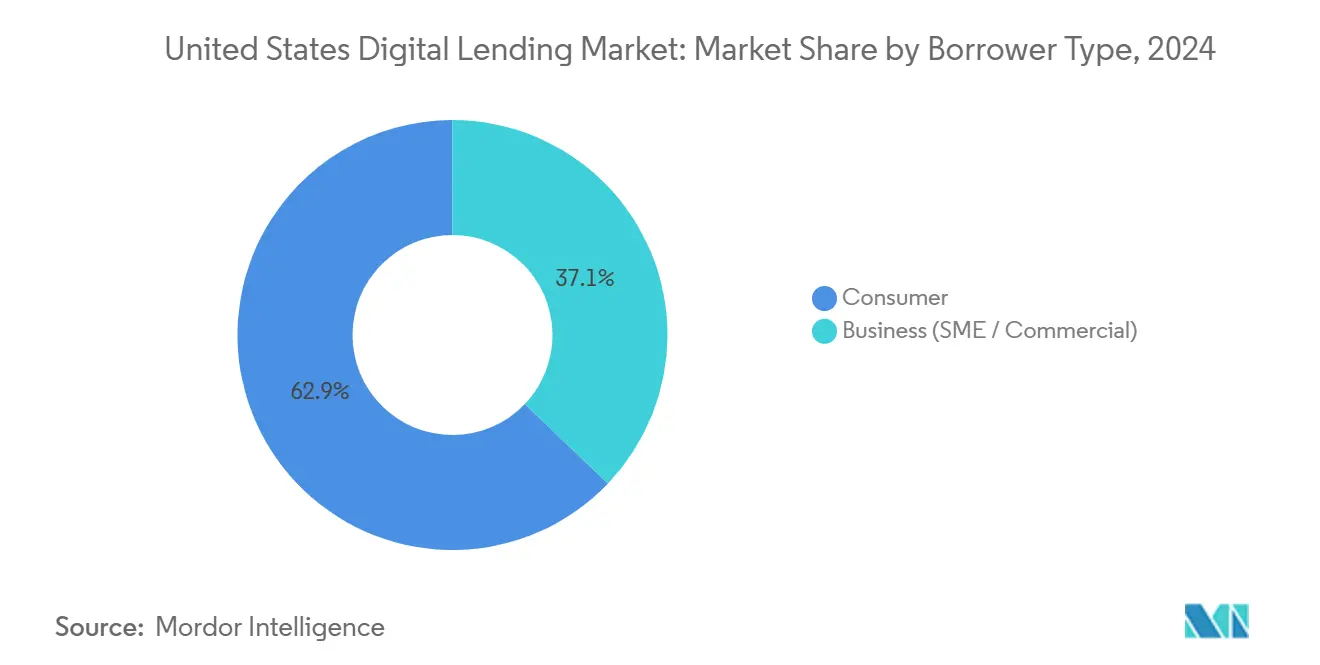
By Provider Type: Traditional Banks Face Fintech Disruption
Traditional institutions still held 32.80% of United States digital lending market share in 2024, yet fintechs outpace them, especially in whole-loan balance-sheet models projected to grow at 14.90% CAGR. Banks accelerate digital initiatives but 14% report less than 25% completion, giving nimble entrants an edge. Credit unions leverage community roots, yet must modernize interfaces. Embedded-finance lenders integrate directly into software used by merchants, capturing borrowers at the transaction point, which conventional banks struggle to emulate.
Fintech platforms grow nearly three times faster than banks, according to FDIC research that also highlights potential systemic risks tied to uninsured deposits. Regulators may tighten controls, favoring incumbents with established compliance processes. Whole-loan sales attract pension funds seeking stable yield without securitization complexity, giving balance-sheet lenders predictable funding lines.
By Funding Source: P2P Leadership Amid Securitization Growth
P2P and fractional funding captured 52.50% of the United States digital lending market size in 2024. Retail and accredited investors chase yields unavailable in money-market funds, while platforms provide automated diversification. Securitizations are growing at 15.10% CAGR as loan-level performance data matures; SoFi’s USD 525 million 2025 deal with PGIM Fixed Income extended a USD 3.9 billion track record. Whole-loan buyers include asset managers and insurance firms eager for direct exposure and simplified structure. Many lenders now pursue hybrid capital stacks, mixing warehouse lines, ABS issuance, and marketplace funding to optimize costs and liquidity.
Regulatory scrutiny of consumer-loan ABS quality encourages issuers to enhance credit enhancement and reporting transparency. The shift toward real-time servicing data improves investor confidence and may compress spreads, supporting further securitization volume.
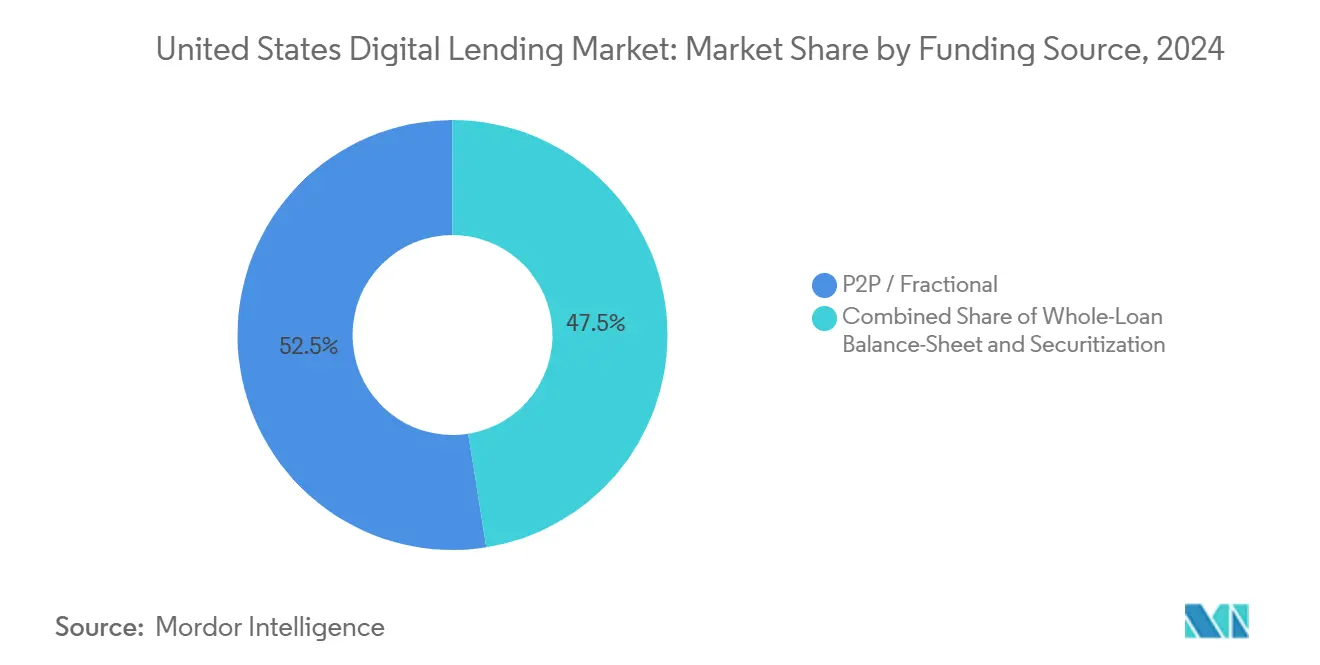
Note: Segment shares of all individual segments available upon report purchase
By Region: Northeast Stability Versus West Coast Innovation
The Northeast retained 38.98% share in 2024, reflecting proximity to capital markets, dense consumer wealth, and seasoned regulatory counsel. New York’s legal ecosystem streamlines securitization issuance, while Boston supplies fintech talent. West Coast volume grows at 18.20% CAGR, propelled by venture capital, AI engineers, and a culture of rapid experimentation. Upstart’s marketplace, headquartered in California, automated 91% of decisions for 240,706 loans in Q1 2025. Southeast, Midwest, and Southwest regions attract lenders targeting lower costs and untapped demographics. State policy divergence, such as California’s consumer-protection laws and emerging BNPL licenses in New York, forces multi-state compliance playbooks.
Local community banks in the Northeast still dominate real-estate lending, so digital challengers partner rather than compete head-on. The West’s entrepreneurial base demands flexible credit, fueling embedded platforms. Middle-America lenders leverage hybrid digital-branch strategies to retain relationship advantages while improving efficiency. Regional diversity ensures portfolio diversification opportunities for nationwide platforms.
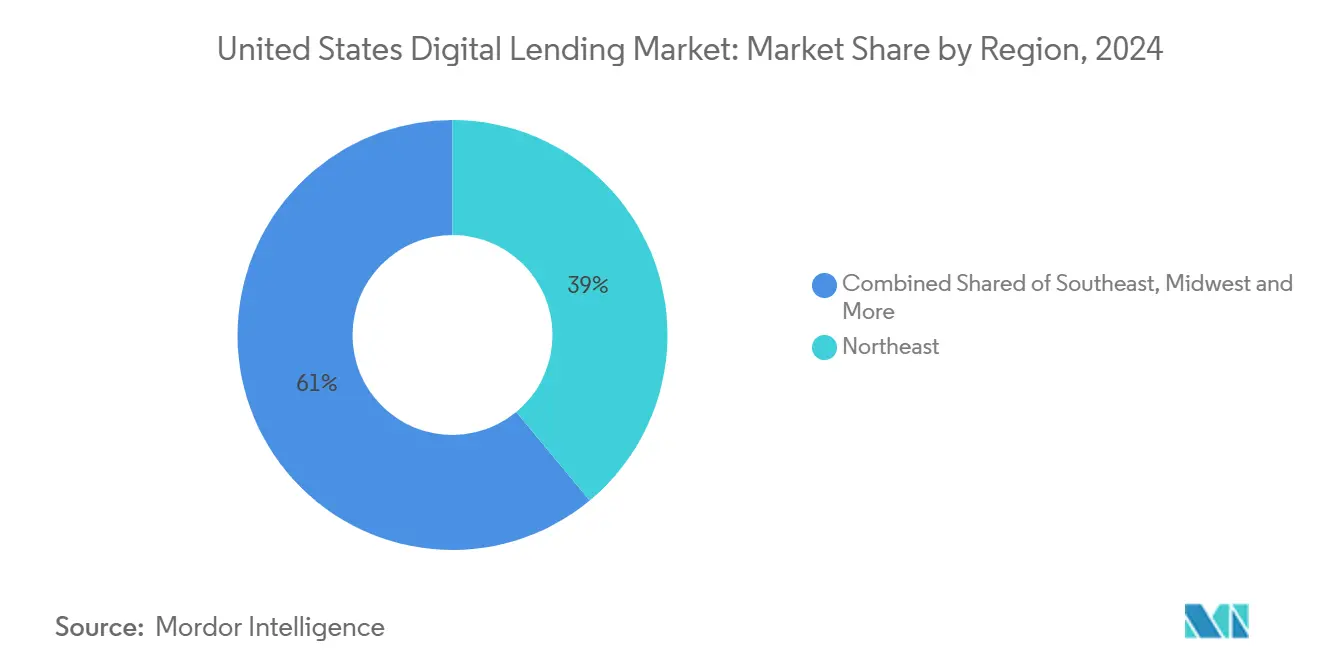
Note: Segment shares of all individual segments available upon report purchase
Geography Analysis
Borrowers in the Northeast underpin 38.98% of 2024 originations as deep capital markets, long-tenured regulators, and affluent demographics support high average loan balances. Established securitization counsel and investor networks speed ABS execution, letting lenders recycle capital swiftly. Community banks sustain relationship-lending niches, yet digital challengers chip away by promising 24/7 approvals and same-day funding. State-level licensure remains rigorous but predictable, a benefit for scaled operators.
The West Coast is on track for an 18.20% CAGR through 2030. Venture-funded fintech hubs in California and Washington incubate AI talent pools and product managers who prioritize user-first design. Upstart and similar platforms demonstrate how regional creativity converts to national distribution when paired with bank partnerships. High-income, tech-forward populations accept mobile-only workflows, and regulators often test pilot programs that later inform federal policy. Demand for embedded financing in SaaS applications is highest in technology-dense corridors, amplifying growth.
Southeast, Midwest, and Southwest states deliver cost advantages, growing consumer bases, and sector-specific opportunities such as agricultural and energy lending. Regulatory permissiveness varies. Some jurisdictions adopt “true-lender” statutes that raise compliance hurdles, while others court fintech entrants with sandbox programs. Community-bank dominance persists, suggesting collaboration will outperform direct competition. Digital platforms tailor credit models to local industries—manufacturing in the Midwest, tourism in the Southeast—to win share without costly national marketing campaigns.
Competitive Landscape
More than 100 banks and credit unions now appear on AI-driven loan marketplaces, demonstrating fragmentation and opportunity. Fintechs such as Upstart, SoFi, LendingClub, and Upgrade scale using alternative-data credit models and seamless mobile UX. Traditional banks pursue defensive acquisitions; Gen Digital’s USD 1 billion purchase of MoneyLion and TransUnion’s acquisition of Monevo’s pre-qualification engine illustrate consolidation motives to acquire technology quickly. White-space growth lies in vertical SaaS partners like Lendica that embed underwriting within industry software and share fees, lowering customer acquisition cost.
Technology rivalry focuses on real-time decisioning, explainable AI, and predictive fraud analytics. Upstart’s automation surpasses 90% of loan approvals, while SoFi bundles banking, investing, and insurance to deepen relationships. Rising digital-ad costs squeeze margins, so platforms refine lifetime-value analytics and cross-sell. Regulators scrutinize data-privacy and true-lender compliance, favoring operators with strong governance. Cybersecurity underinvestment—acknowledged by 70% of providers—remains a systemic vulnerability that could trigger regulatory mandates or consumer backlash.
United States Digital Lending Industry Leaders
-
SoFi
-
LendingClub
-
Upstart
-
Affirm
-
OnDeck
- *Disclaimer: Major Players sorted in no particular order
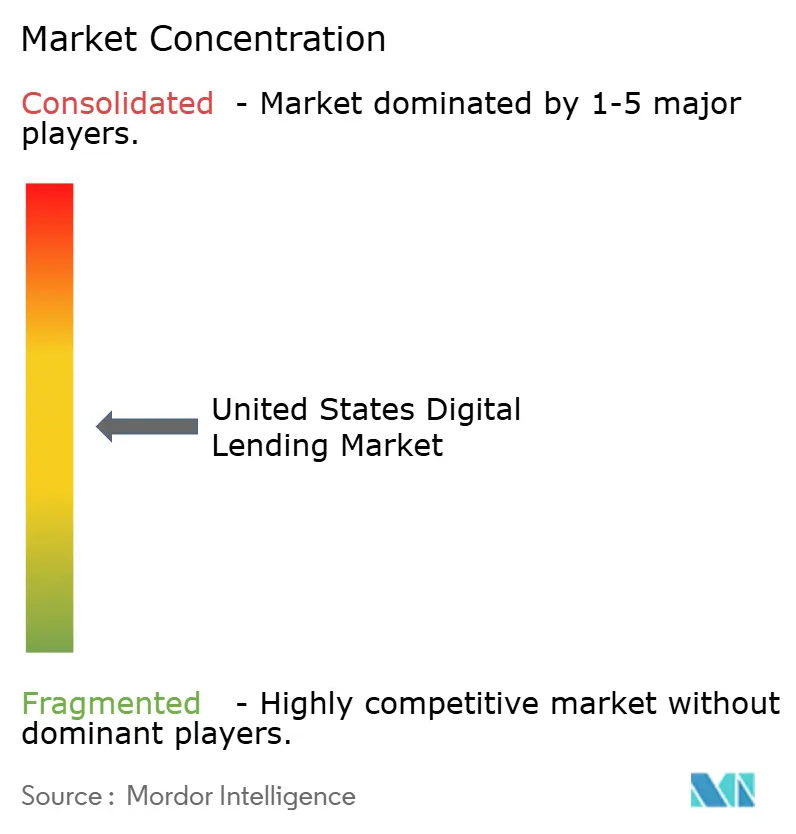
Recent Industry Developments
- May 2025: SavvyMoney acquired CreditSnap to compress application time from 12 minutes to 2 minutes for partner institutions.
- May 2025: Lendflow raised USD 15 million from Trinity Capital to expand AI-powered embedded credit infrastructure.
- February 2025: SoFi and PGIM Fixed Income priced a USD 525 million personal-loan securitization, extending the lender’s ABS track record.
- January 2025: Vontive received equity investment from Citi’s SPRINT team and launched USD 150 million VNTV 2025-RTL1 securitization to scale its investment-real-estate platform.
Research Methodology Framework and Report Scope
Market Definitions and Key Coverage
Mordor Intelligence defines the United States digital lending market as the total value of loans that are originated, underwritten, disbursed, and serviced entirely through web or mobile interfaces, whether the provider is a bank, credit union, fintech balance-sheet lender, peer-to-peer marketplace, or embedded point-of-sale platform. Activity tied only to software licence fees or back-office loan-processing services is outside this boundary.
Scope Exclusions: Pure "loan-origination-software" revenue, crypto-denominated loans, and intragroup treasury transfers are excluded.
Segmentation Overview
- By Borrower Type
- Consumer
- Business (SME / Commercial)
- By Provider Type
- Traditional Banks
- Credit Unions
- Marketplace / Balance-Sheet FinTechs
- Embedded-Finance / Platform Lenders
- By Funding Source
- Whole-Loan Balance-Sheet
- Securitisation
- P2P / Fractional
- By Region
- Northeast
- Southeast
- Midwest
- Southwest
- West
Detailed Research Methodology and Data Validation
Primary Research
To validate desk findings, Mordor analysts conduct semi-structured interviews with executives at national banks, balance-sheet fintechs, credit-union service organizations, and securitization desks across the Northeast, Midwest, and Pacific hubs. Borrower-side surveys and lender advisory councils help us stress-test assumptions on channel mix, pricing spreads, and approval times.
Desk Research
Our analysts begin by assembling supply-side data from U.S. call reports, FFIEC tables, and Consumer Financial Protection Bureau filings, supplementing these with Federal Reserve consumer-credit series and FDIC household banking surveys. Trade associations such as the Online Lenders Alliance and the Structured Finance Association provide granular origination, delinquency, and securitization disclosures. Public 10-Ks from leading listed lenders, state regulator dashboards, and patent libraries (via Questel for AI-scoring patents) further refine cost-of-risk and technology-adoption metrics. This list is illustrative; many additional public and proprietary sources inform the evidence base.
Market-Sizing & Forecasting
We adopt a top-down reconstruction that starts with Federal Reserve loan-stock and flow data, then adjusts for digital-only penetration using borrower-level adoption rates surfaced in primary research. Selective bottom-up spot checks, for example, aggregating 2024 consumer-loan securitizations or sampled average-ticket-size × volume for SME platforms, are layered in to reconcile totals.
Key variables shaping the model include:
1. Mobile-first origination share of total unsecured credit,
2. Embedded-finance loan volume inside retail checkouts,
3. Fintech securitization issuance,
4. Average coupon spreads over Prime,
5. Real-time payment rail uptake.
A multivariate regression links these drivers to digital-origination growth, while ARIMA smoothing handles seasonality tied to tax-refund and holiday spending.
Where bottom-up gaps remain (e.g. private-credit warehouse draws), ratios derived from primary interviews bridge the data.
Data Validation & Update Cycle
Outputs pass a three-layer review: analyst, lead author, and senior domain expert. Variances above preset thresholds trigger re-contact of at least one market participant. Models refresh annually; material regulatory or funding-cost shocks prompt interim revisions, ensuring clients always receive the freshest view.
Why Mordor's US Digital Lending Baseline Stands Apart
Published values frequently diverge because each firm picks different units, revenue bases, and loan stages before annualizing.
Key gap drivers include: rivals that report platform revenue only, others that cite alternative-lending niches such as P2P, and some that freeze FX or discount rates from prior years, whereas our study rolls forward Fed rate moves and securitization haircuts before triangulating.
Benchmark comparison
| Market Size | Anonymized source | Primary gap driver |
|---|---|---|
| USD 303.07 B (2025) | Mordor Intelligence | - |
| USD 284.52 B (2024) | Regional Consultancy A | Uses broader "alternative lending" tag yet omits credit-union volumes and adjusts neither for charge-offs nor refinancing churn |
| USD 2.86 B (2024) | Trade Journal B | Captures only software-platform revenue, excluding underlying loan principal and interest amounts |
In short, our transparent scope selection, dual-track modeling, and annual source refresh give decision-makers a dependable, reality-checked baseline that balances breadth with traceable data paths.
Key Questions Answered in the Report
What is the current size of the United States digital lending market?
The market stands at USD 303.07 billion in 2025 and is projected to reach USD 560.97 billion by 2030 at a 13.10% CAGR.
Which borrower segment leads digital lending volume?
Consumer lending dominates with 62.87% share in 2024 and is on track for a 14.20% CAGR through 2030.
How fast is the West Coast digital lending sector growing?
West Coast originations are forecast to expand at 18.20% CAGR, the fastest among all regions.
Why is AI-driven alternative-data scoring important?
Machine-learning models using alternative data reach 93% accuracy, widening credit access while cutting defaults and boosting lender profitability.
Page last updated on:
